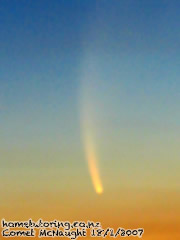News Archive
Other news pages:
Current news |
2024 news |
2023 news |
2022 news |
2021 news |
2020 news |
2019 news |
2018 news |
2017 news |
2016 news |
2015 news |
2014 news |
2013 news |
2012 news |
2011 news |
news archive
Wednesday 10 December 2008 – treasure hunt
Wednesday 18 April 2007 – Refugee Day
The refugee training day (that's training in case of refugees,
not training of refugees) on Wednesday 18 April 2007 went well.
(Officially it's known as the Operational Planning Exercise of the RedR
NZ training course Essentials of Humanitarian Practice, which is a bit
of a mouthful.) Refugees were represented by six Hallidays, two Dixons
(A and Z) and two Frosts (J and H).
The recorders were particularly effective for distracting the workers,
but it was surprising how a kidnapping of one aid worker for 18 hours
(game time) didn't cause more concern with her fellow workers.
Thursday 18 January 2007 – Comet McNaught
Lovely photo opportunity on the top of Mt Roskill. More on the Comets page.
 
16 October 2006 – it's official, we have a couple of new elements
PHYSICS NEWS UPDATE
The American Institute of Physics Bulletin of Physics News
Number 797 October 16, 2006
ELEMENTS
116 AND 118 ARE DISCOVERED. At the Joint Institute for Nuclear Research
(JINR) in Dubna, Russia, physicists (including collaborators from Lawrence
Livermore National Lab in the US) have sent a beam of calcium-48 ions
into a target of californium-249 atoms to create temporarily a handful
of atoms representing element 118. The nucleus for these atoms have
a total atomic mass of 294 units. In fact, only three of these atoms,
the heaviest ever produced in a controlled experiment, were observed.
After sending 2 x 1019 calcium projectiles into the target,
one atom of element 118 was discovered in the year 2002 and two more
atoms in 2005. The researchers held up publication after seeing their
first specimen in order to find more events. ...
In searching through 1019 collision events, how do you
know you have found a new element? Because of the clear and unique decay
sequence involving the offloading of alpha particles, nuclear parcels
consisting of two protons and two neutrons. In this case, nuclei of
element 118 decay to become element 116 (hereby itself discovered for
the first time), and then element 114, and then element 112 by emitting
detectable alphas. The 112 nucleus subsequently fissions into roughly
equal-sized daughter particles. The average lifetime observed for the
three examples of element 118 was about one millisecond, not long enough
to perform any kind of chemical tests (you'd need an hour's time for
that). Element 118 lies just beneath radon in the periodic table and
is therefore a kind of noble gas.
The Dubna-Livermore team previously announced
the discovery of elements 113 and 115 and next hope to produce element
120 by crashing a beam of iron atoms into a plutonium target. ...
27 September 2006 – anniversary
Today marks 101 years since Albert Einstein
came up with the formula E = mc2 (it was slightly rearranged
when he first wrote it).
31 July 2006 – C14 in diamonds
This report from Creation
on the Web (first published: Creation 26(2):42–44, March 2004):
Dr Baumgardner [of Los Alamos National Laboratory in the USA] sent
five diamonds to be analyzed for 14C. It was the first time
this had been attempted, and the answer came back positive — 14C
was present. The diamonds, formed deep inside the earth, are assumed
by evolutionists to be over a billion years old. Nevertheless they contained
radioactive carbon, even though, if the billion-year age were correct,
they ‘shouldn’t have’.
This is exceptionally striking evidence, because a diamond has remarkably
strong lattice bonds (that’s why it’s the hardest substance
known), so subsequent atmospheric or biological contamination should
not find its way into the interior.
The diamonds’ carbon-dated ‘age’ of about 58,000
years is thus an upper limit for the age of the whole earth. Again,
this is entirely consistent with helium diffusion results reported above,
which indicate the upper limit is in fact substantially less.
11 July 2006 – digital players and deafness
The NZ Herald with Digital
players raise deafness fears. It seems that listening to digital music
players can lead to hearing loss, not because they're any louder than
older music players but because the batteries last longer.
20 March 2006 – what girls and boys like to learn about
The New Zealand Herald chimes in with an article on what sort of things boys and girls like to learn
about. And guess what? They're not the same.
Number one for boys: Explosive chemicals.
Number one for girls: Why we dream when asleep and what does it mean?
4 May 2005 – more sleep, better results
An NZ
Herald article on the benefits of teenagers sleeping in, including doing better
at school.
Other News
Other news pages:
Current news |
2024 news |
2023 news |
2022 news |
2021 news |
2020 news |
2019 news |
2018 news |
2017 news |
2016 news |
2015 news |
2014 news |
2013 news |
2012 news |
2011 news |
news archive
|

